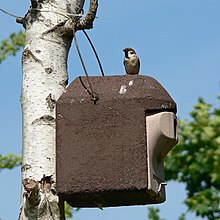Wood concrete

Wood-concrete is made of sawdust and cement existing material for the production of bricks and molded parts in construction. Another area of application in nature conservation is nesting boxes , breeding caves and wintering quarters for various animals.
A mixture of sawdust and Sorel cement , on the other hand, is called stone wood and is mainly used for the production of screed and floor coverings .
Manufacturing and processing
The mixture of five parts by volume of sawdust and three parts by volume ( low-chromate to avoid allergies ) cement is mixed with water until it has the consistency of damp garden soil. When squeezing out a handful, a small amount of liquid should drip off. The addition of calcium chloride accelerates the setting.
For processing, molds must first be made into which the pasty mass is pulped. The durability of the material is very good , especially with protective slurries , paints or plaster applied after drying and can last for several decades.
history
During the Second World War, extensive tests with wood-concrete were carried out in Germany in order to make this building material usable for makeshift homes within the framework of the German Housing Fund. The war-related shortage of cement called for other aggregates such as blast furnace or lignite slag; The makeshift homes built in this way generally had a short lifespan and insufficient weather resistance, as the wood contained was not adequately protected against the ingress of moisture.
1949–1950 single-family houses were built from wood-concrete bricks. Despite the small outer wall thickness (16 cm), the houses have a very low energy consumption and are today, almost 70 years later, still in good condition.
Homes made of wood-concrete emerged in the GDR as single-storey type houses in the early 1970s. The single-family house type HB4 from VEB Landbauprojekt Potsdam was designed with only one living area and a flat pitched roof. There are around 80 m² of living space available, a partial cellar was planned. The gross volume (previously enclosed space) was then projected to be around 427 m³.
In 2011, as part of a project for the Bauhaus University Weimar, the first passive house made of wood-concrete was built, the prefabricated wood-frame construction elements of which were clad with wood-concrete panels, which mainly consist of wood chips .
In Austria and some other countries, wood concrete is widespread as a building material in the form of mantle blocks for filling with concrete, also in multi-storey buildings. Brand names are e.g. B. Isospan , Durisol and internationally also Nexcem .
Trivia
Bois Durci ( [bwa dyʀsiː] , French for “hardened wood”) was the name given to a natural plastic in France in the middle of the 19th century, which was made from a mixture of wood flour and ox blood . After drying and with heating, it was pressed into shaped pieces.
See also
- Wood wool lightweight board , another building material made from shredded wood ( wood wool ) and cement with the brand name Heraklith
- Wood-concrete composite
Individual evidence
- ^ GDR home type HB4 on www.gutachter-wagner.de
- ^ MDR report, July 19, 2011 ( Memento from September 26, 2011 in the Internet Archive )
- ^ Report on the experimental green: house building by Prof. Stamm-Teske, Deutsche Bau-Zeitschrift, 12/2011
Web links
- Wood concrete for bat caves and bird boxes (accessed August 7, 2020)
- Wood concrete (accessed August 7, 2020)
- On the short-term and long-term behavior of wood-concrete (accessed on August 7, 2020)
- INVESTIGATIONS ON POSSIBILITIES OF LIGHTWEIGHT WOOD CONCRETE IN THE AREA OF BUILDING FACADES (accessed on August 7, 2020)